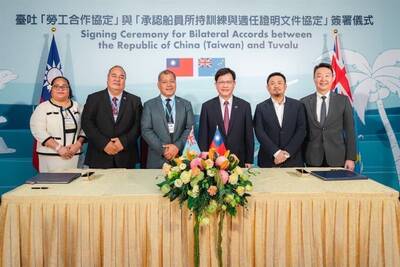The removal of a check dam from the Shei-pa National Park in 2011 has led to a dramatic increase in the population of the critically endangered Formosan landlocked salmon, a professor said yesterday.
The number of salmon has grown from fewer than 500 in 2001 to 5,400 this year, said National Chung Hsing University professor Lin Hsing-juh (林幸助), who started a 10-year project in 2004 with 20 other academics to monitor and research the fish.
The 15m by 3m Check Dam No. 1 of the Chichiawan Creek, one of 10 built on the river to reduce channel erosion and prevent sediment from filling a downstream reservoir, was torn down in May 2011.
The research team found that the dam left the fish vulnerable to big storms. When the creek was hit by a typhoon or flooding, the salmon would be flushed from their natural habitat in the creek’s upper reaches to points downstream, Lin said.
The cold-water fish would try to migrate upstream, but were prevented by the dam, leaving them to die in the warmer water of the creek’s lower reaches, Lin said.
During each major storm, one-third of the Formosan landlocked salmon in the region perished, he said.
The current salmon population has nearly reached the creek’s maximum capacity of 5,800 salmon, Lin said, but he added that the species is threatened by pollution caused by the production of high-mountain vegetables, fruit and tea grown nearby on Wuling Farm (武陵農場).
Nitrates in the fertilizers found in washed off soil pollute the creek and prevent the salmon from breathing, he said.
The species, a holdover from the last Ice Age, needs unpolluted waters to survive and is now found only in the country’s Cijiawan Creek (七家灣溪) and Gaoshan Creek (高山溪) in the upper reaches of the Dajia River (大甲溪).

The Ministry of Economic Affairs has fined Taobao NT$1.2 million (US$36,912) for advertisements that exceed its approved business scope, requiring the Chinese e-commerce platform to make corrections in the first half of this year or its license may be revoked. Lawmakers have called for stricter enforcement of Chinese e-commerce platforms and measures to prevent China from laundering its goods through Taiwan in response to US President Donald Trump’s heavy tariffs on China. The Legislative Yuan’s Finance Committee met today to discuss policies to prevent China from dumping goods in Taiwan, inviting government agencies to report. Democratic Progressive Party Legislator Kuo Kuo-wen (郭國文) said

The Ministry of Economic Affairs has fined Taobao NT$1.2 million (US$36,900) for advertisements that exceeded its approved business scope and ordered the Chinese e-commerce platform to make corrections in the first half of this year or its license would be revoked. Lawmakers have called for stricter supervision of Chinese e-commerce platforms and more stringent measures to prevent China from laundering its goods through Taiwan as US President Donald Trump’s administration cracks down on origin laundering. The legislature’s Finance Committee yesterday met to discuss policies to prevent China from dumping goods in Taiwan, inviting government agencies to report on the matter. Democratic Progressive Party

Taiwan and its Pacific ally Tuvalu on Tuesday signed two accords aimed at facilitating bilateral cooperation on labor affairs, according to Taiwan’s Ministry of Foreign Affairs (MOFA). The governments inked two agreements in Taipei, witnessed by Foreign Minister Lin Chia-lung (林佳龍) and visiting Deputy Tuvaluan Prime Minister Panapasi Nelesone, MOFA said in a news release. According to MOFA, the agreements will facilitate cooperation on labor issues and allow the two sides to mutually recognize seafarers’ certificates and related training. Taiwan would also continue to collaborate with Tuvalu across various fields to promote economic prosperity as well as the well-being of their

Sung Chien-liang (宋建樑), who led efforts to recall Democratic Progressive Party (DPP) Legislator Lee Kun-cheng (李坤城), was released on bail of NT$80,000 today amid outcry over his decision to wear a Nazi armband to questioning the night before. Sung arrived at the New Taipei District Prosecutors’ Office for questioning in a recall petition forgery case last night wearing a red armband bearing a swastika, carrying a copy of Adolf Hitler’s Mein Kampf and giving a Nazi salute. Sung left the building at 1:15am without the armband and covering the book with his coat. Lee said today that this is a serious